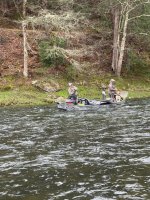Take that one step further. There's a difference between being a great target shooter, and a great shooter, even taking great "hunter" out of the equation.
I see guys, I'm one of them, trying to get 1/2 MOA off a bench. Load their own shells to exacting tolerances, picking match bullets, etc. Figuring out which rifle likes which loads. Sit on a bench, with carefully placed rests, controlling their breathing, squeezing the trigger just so, having hair triggers on the guns, adjusts the scope if the group is 1/2 inch to the right, on longer shooting dial in distances on their scope. All that. Putting a 5 shot group through one ragged hole at 100 yards. It's a sport in it's own right. And guy #2 beside him throws 1 random shell in the gun, hits within 4" of the bull, calls it good and leaves.
In the woods, guy #1 is scoping a buck to count points, ranging it with his rangefinder and readying his shooting stick, by the time he's ready to shoot the buck is looong gone. Deer runs off to guy #2, now at a full run at 200 yards, he shoulders the gun and shoots offhand a split second after the gun hits his shoulder, and a deer falls dead. Who's the better shooter?
I grew up a rabbit hunter with beagles, reaction shooting with double barrels. I recall times shooting, and then not even remembering seeing a rabbit, and being openly worried about why the hell I just did that, why did I shoot? But then you walk up and there's a dead rabbit. We hunted with a guy who used a worn out single shot, he carried an extra shell in his left hand and would get a second shot off quicker than some of us with the side by sides. I've seen my dad hunt deer with a lever action, open sights, I'm trying to find it in the scope looking for horns and he downs it in it's tracks at 250 yards running full speed, and your jaw just drops. After bragging about your 1/2 MOA group, you feel kinda silly, just got showed up by pops who was happy to hit the paper, and he'll smile and say something like "didn't all that reaction shooting teach you anything?"
There's a difference between a good target shooter and being a good shot. There's a difference between being a good competition caster and being a good caster on the water.




